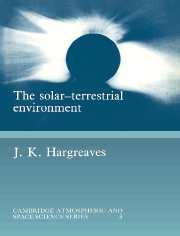 The Solar-Terrestrial Environment
The Solar-Terrestrial Environment Published online by Cambridge University Press: 29 January 2010
Someone told me that each equation I included in the book would halve the sales.
S. W. Hawking, A Brief History of Time (1988)(Health warning – This chapter has more equations than any other.)
The purpose of this chapter is to summarize points of physics that will be needed in order to grasp the fundamentals of geospace science. It is assumed that the student is already familiar with basic physical concepts such as energy, temperature, quanta, waves, molecules, heat, and electric and magnetic fields – topics, it will be noted, which come mainly within the domain of classical physics. Most students of physics will have covered these areas in the first year or two of their university courses. But, like most specialities, upper atmosphere and space science have their own peculiar slant. We have to deal with a gas, and in particular with an electrified gas. We will be concerned with the propagation of waves – mainly electromagnetic waves, but some others too – in that gas. We shall need to know how a steady magnetic field affects the behaviour of gas and of waves. Energetic particles and photons will enter the gas, and their interactions have to be included. So the present chapter outlines the relevent background. Much of the material should be revision but some may be new.
It is up to the student whether to study this chapter thoroughly before tackling the subsequent ones, or merely to scan it through now in order to return for clarification later, if and when questions arise.
To save this book to your Kindle, first ensure [email protected] is added to your Approved Personal Document E-mail List under your Personal Document Settings on the Manage Your Content and Devices page of your Amazon account. Then enter the ‘name’ part of your Kindle email address below. Find out more about saving to your Kindle.
Note you can select to save to either the @free.kindle.com or @kindle.com variations. ‘@free.kindle.com’ emails are free but can only be saved to your device when it is connected to wi-fi. ‘@kindle.com’ emails can be delivered even when you are not connected to wi-fi, but note that service fees apply.
Find out more about the Kindle Personal Document Service.
To save content items to your account, please confirm that you agree to abide by our usage policies. If this is the first time you use this feature, you will be asked to authorise Cambridge Core to connect with your account. Find out more about saving content to Dropbox.
To save content items to your account, please confirm that you agree to abide by our usage policies. If this is the first time you use this feature, you will be asked to authorise Cambridge Core to connect with your account. Find out more about saving content to Google Drive.